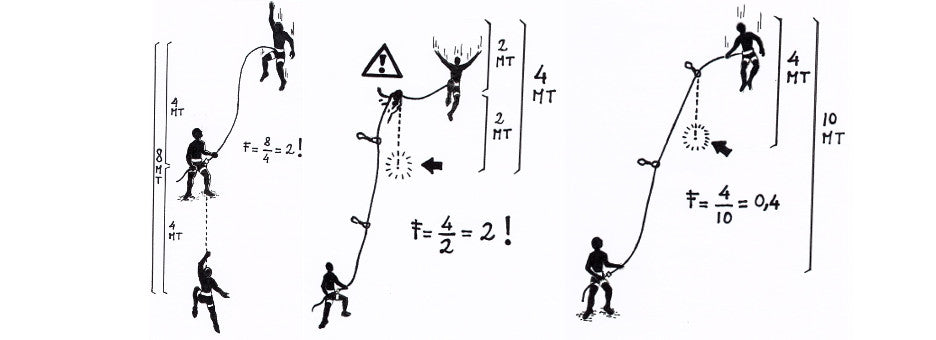
The Fall Factor in Climbing
Share
The fall factor is defined as the ratio of the length of the fall to the length of the rope between the falling climber and the belay point; note that the rope is locked at the belay point.
The blocked rope implies the description of the worst case, that is, the case in which the brake has not come into operation for the most disparate reasons, such as the rope being stuck in a crack or on a spike.
In mountaineering, in the worst case, you can get a fall factor of two.
For example, a climber who flies eight meters, with a rope length of four meters, determines a fall factor of two.


Note also that even a rope stuck around a spike can cause a fall factor of 2.
Whenever we talk about a fall factor in the presence of an unblocked rope, we are committing a conceptual error.
To avoid having the rope blocked at the belay point, you need to use a system to slow down the fall, that is, your partner who belays you must know how to correctly use any type of brake, such as a Munter hitch or tuber.

Since a body in free fall acquires an ever-increasing amount of kinetic energy, this, always in the presence of a blocked rope, is entirely absorbed by the rope, which, by stretching, is able to behave like a sort of elastic band, progressively slowing the flight. The body that is then slowed is subject to the so-called stopping force. The smaller the stopping force, the smoother the braking.
Paradoxically, if a non-deformable steel cable were used for climbing, the kinetic energy would be completely absorbed by the human body which would be abruptly stopped with a deceleration value well above the 15g analyzed in the article Flight Dynamics - Theory Notes . Similarly, if a bungee jumping elastic were used, it would not be possible to modulate the braking and above all it would not be manageable, neither by the climber nor by the belayer.
Although climbing ropes are dynamic and have a certain degree of elasticity, it is essential to slow down falls and not block them.
Practical implications:
- All strings are approved to generate stopping forces that ensure they never reach 15g during deceleration.
- When buying a rope it is a good idea to check its stopping power; the lower it is, the more elastic it is.
- A climber weighing more than 70 kg probably does not need particularly elastic ropes, while a light climber, such as a girl, will opt for a more elastic rope.
- Under no circumstances should you climb with non-approved ropes.
- It is essential to know how to stop your partner from falling by using the correct brake depending on the situation you are facing.
- While climbing, the climber must guide the rope avoiding excessively sharp angles, which would generate excessive friction and prevent the brake from working.
